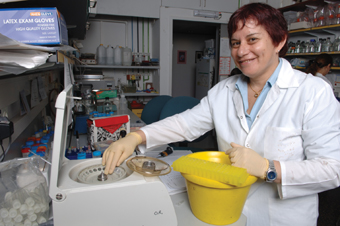Are you a journalist? Please sign up here for our press releases
Subscribe to our monthly newsletter:

One of the most fascinating aspects of embryonic development is the formation of the brain: Billions of newborn brain cells migrate to precise locations, where they begin sending out extensions and establishing connections – eventually creating the command and control apparatus that allows us to move, think and feel. Disruptions in these formative processes can lead to such disorders as schizophrenia, degenerative brain diseases and lissencephaly, or “smooth brain,” which causes severe mental retardation and premature death.
Prof. Orly Reiner of the Weizmann Institute’s Molecular Genetics Department searches for the genes responsible for brain development. She has recently focused on a gene called Par1, which makes an enzyme that regulates the shape and hardiness of nerve cell structures. In research reported in the Journal of Neuroscience, Reiner showed that the Par1 enzyme actively controls the migration of nerve cells in the course of embryonic development, and that its presence in the right amount is critical to the formation of normal brain structure.
In the first stage of the research, Dr. Tamar Sapir and students Sivan Sapoznik, Danit Finkelshtein and Anat Shmueli, and lab technician Talia Levy, working in Reiner’s lab, sought to check what happens when Par1 activity in the brain of the developing embryo is blocked. They injected short RNA molecules into the brains of embryonic mice that were designed to attach themselves to the Par1 gene and prevent it from making an active enzyme. In addition, the scientists equipped the cells with a gene manufacturing a fluorescent material that acts as a beacon, enabling them to track the cells’ migration.
The researchers discovered that blocking the Par1 gene delayed the migration of nerve cells. Whereas in the control mice these cells reached the outer layer of the cortex, in the mice that had their Par1 gene silenced, the nerve cells got “stuck” partway through their journey. The cells stopped short at a well-defined location – precisely the juncture at which they normally undergo structural changes.
Next, the scientists rescued the stuck nerve cells by introducing new copies of the Par1 gene using genetic engineering methods. The “rescue” worked only when the dose was precise: Excessive gene concentrations led to the creation of malformed, rounded cells that lacked the normal nerve cell extensions.
In an additional series of experiments, the researchers checked how exactly Par1 affects cell migration. Apparently, the gene regulates the stability of the cell’s supportive framework, the cytoskeleton. When Par1 is blocked, the cytoskeleton stiffens, making it difficult for the cell to move. In particular, the centrosome, the cytoskeleton’s central structure, which normally drives the cell forward, slows down and loses its precise sense of direction.
“Cell migration and structural changes are interconnected processes,” says Reiner. “Our findings indicate that Par1 links them together by exerting dual control – over the direction of the cell movement and the dynamics of the cell skeleton.” Reiner hopes that a deeper understanding of nerve cell migration will, in the future, help advance the treatment of diseases caused by faulty neurons. Such understanding, for example, could be crucial for developing therapies based on injecting healthy nerve cells into the sick brain and directing the cells precisely to the damaged area.
Prof. Orly Reiner’s research is supported by the Nella and Leon Benoziyo Center for Neurological Diseases; the Kekst Family Center for Medical Genetics; the David and Fela Shapell Family Center for Genetic Disorders Research; and the PW-Iris Foundation. Prof. Reiner is the incumbent of the Bernstein-Mason Chair of Neurochemistry.